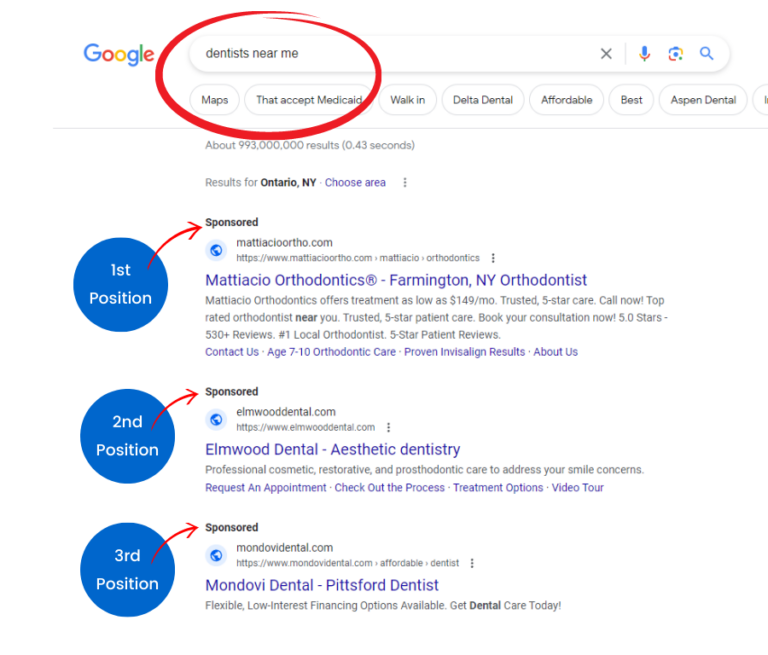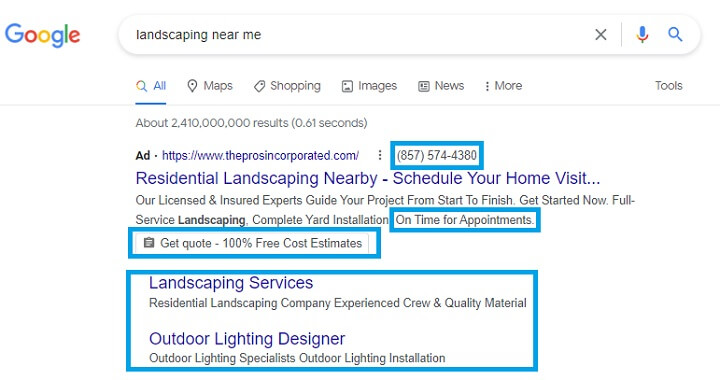How to Improve Your Google Search Ad Campaign
Google Search Ads are what most people typically think of when they hear about Google Advertising. Your customers are turning to Google to search for businesses to help them address a problem or need they have and you can pay to show up in front of them at the top of the results page. This is why, when done correctly, Search Ad campaigns can be wildly helpful to businesses looking to reach their target audience and drive conversions and revenue.

With the right strategies and optimization techniques, you can maximize the performance of your search ads and achieve better results. In this blog post, we will explore the top ways to improve your Google Search Ad campaign, covering various factors that contribute to its success. Before that however, let’s first touch on how Google determines which search ads to display at the top of the search engine results page (SERP) and ways that you can increase your chances to get that coveted top spot.
How Google Determines Top Search Ads:
Google uses an algorithm known as Ad Rank to determine the placement of search ads on the SERP. Ad Rank is calculated based on factors such as bid amount, ad quality, expected click-through rate, landing page experience, relevance, and the ad’s expected impact on the user experience. While bid amount plays a role, it’s not the sole determining factor.
Google has done a great job of becoming THE trustworthy source that people turn to when they have questions and are looking to search the internet. This is something that they want to maintain and continue to strengthen, so they aim to display ads that are relevant, engaging, and provide a positive user experience.


Define Clear Campaign Goals:
Before launching your Google Search Ad campaign, it’s important to define your objectives. Clearly identify what you aim to achieve, whether it’s increasing website traffic, generating leads, boosting sales, or enhancing brand visibility. Aligning your campaign goals with specific metrics will help you measure success accurately and optimize accordingly.
Thorough Keyword Research:
Keyword research is a fundamental step in optimizing your search ad campaign. It involves identifying relevant keywords and phrases that your target audience is likely to use when searching for products or services. Utilize Google’s Keyword Planner or other keyword research tools to discover high-volume keywords with low competition. Incorporate these keywords strategically into your ad copy, headlines, and landing pages to improve ad relevance and attract qualified traffic.
Compelling Ad Copy:
Crafting compelling ad copy is vital to entice users to click on your ads. Keep your ad copy concise, persuasive, and relevant to the user’s search intent. Highlight the unique selling points of your products or services, emphasize any promotions or offers, and include a clear call-to-action (CTA) to encourage clicks. Test different variations of ad copy to determine which ones yield the best results.
Landing Page Optimization:
Even the most engaging ads won’t yield results if your landing page doesn’t deliver a seamless user experience. Ensure that your landing page is optimized for relevance and provides a smooth transition from the ad to the page. Align the content on your landing page with the user’s search intent and make sure it loads quickly on all devices. A well-designed and user-friendly landing page increases the likelihood of conversions.
Ad Extensions:
Utilize ad extensions to enhance the visibility and effectiveness of your search ads. Ad extensions allow you to display additional information such as phone numbers, location, product links, or customer reviews. These extensions provide more value to users and increase the likelihood of clicks. Experiment with various ad extensions to find the ones that best suit your campaign goals and target audience.


Ongoing Monitoring and Optimization:
Regularly monitor the performance of your search ad campaign and make data-driven optimizations. Track important metrics such as click-through rate (CTR), conversion rate, cost per click (CPC), and return on ad spend (ROAS). Identify underperforming keywords, ad groups, or targeting settings, and make necessary adjustments. A/B testing different elements of your ads and landing pages can help you refine your strategy and maximize campaign performance.
A Quick Search Campaign Checklist From Our Findings:
When we are tasked with doing an audit for potential clients’ Google Ads campaigns, here are some of the quick things we tend to look for:
- Make sure Google Analytics is installed on your website and is linked to your Google Ads Account.
- Make sure conversion tracking is set up correctly with appropriate prices attached to each to show Google which conversion is weighted heavier than others (ex. Phone Calls vs. Contact Page visits)
- Make sure ads aren’t running 24/7. Run ads during the time when most people are awake, with a bid adjustment during your business hours so hopefully you get most of your conversions when a staff member can answer the phone or follow up immediately.
- Turn of Search Partners and Display Partners. Google will spend a lot of your budget on these partner sites when you want to make sure that you are primarily appearing on Google. Showing up on Google is where the value is.
- Make sure you aren’t using your own name as a keyword. This is case by case dependent as in some cases you may want or even need to target your business name. For example, if lots of your competitors are targeting your business name, pushing your organic listing down the list, you may decide that targeting your name to compete with them is the right move. Generally speaking however, if someone is looking for your business name, that searcher is specifically looking for you and that’s a click we can win organically, rather than paying for it through Google Ads.
- Use as many headings and descriptions as allowed in your Responsive Search Ad so Google can A/B test which combination works best.
- Ensure all of your assets and extensions are built out. This includes location extensions, call extensions, sitelink extensions, callout extensions, structured snippets, and more.
- Split your campaign up into relevant ad groups. The goal is to be as specific and relevant as possible, and splitting your search campaign up by product or service based ad groups allows you to add keywords and ad copy that is relevant to that searcher.
In Summary
Improving the performance of your Google Search Ad campaign requires a combination of strategic planning, continuous optimization, and staying abreast of industry trends. By setting clear goals, conducting thorough keyword research, creating compelling ad copy, optimizing landing pages, leveraging ad extensions, and monitoring performance, you can enhance your campaign’s effectiveness and drive better results. Remember, Google’s focus is on providing users with relevant and valuable ads, so prioritize relevance and user experience throughout your campaign. With a well-executed strategy, you can maximize your ad campaign’s potential and achieve your desired outcomes.
To learn more about optimizing your Google Search Ad campaign or to get expert assistance, give us a call, or fill out the form on our contact page.



